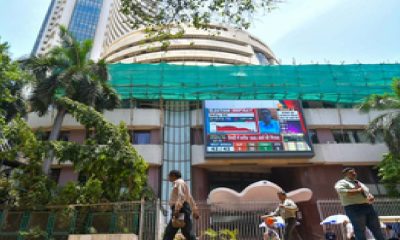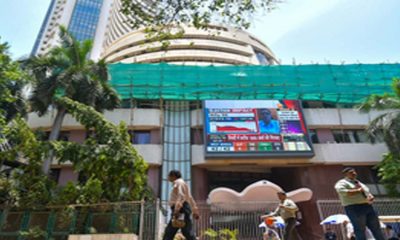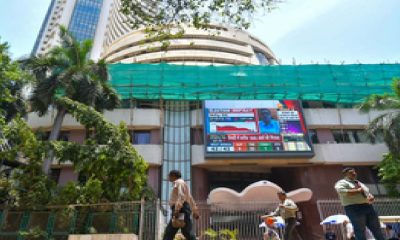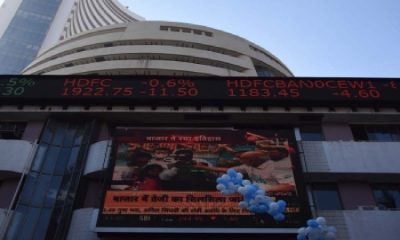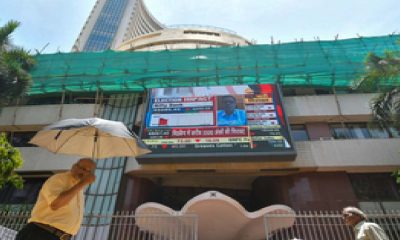Business
Sensex, Nifty slide over 1 pc amid weak global cues, US trade uncertainties

Mumbai, Jan 27: Indian equity markets witnessed a sharp decline on Monday amid weak global cues and uncertainties over US trade policies which dampened domestic investors’ sentiment.
At the closing bell, the BSE Sensex shed 824 points or 1.08 per cent at 75,366, while the NSE Nifty50 slipped 263 points or 1.14 per cent at 22,829.
On the 30-stock Sensex, only six stocks managed to stay in the green. ICICI Bank led the gainers with a 1.75 per cent rise, followed by the SBI, Hindustan Unilever, Asian Paints, UltraTech Cement, and Maruti Suzuki India.
However, the majority of stocks faced losses like Zomato, Tech Mahindra, HCLTech and Tata Motors.
Similarly, on the Nifty50, 10 stocks traded higher. Britannia Industries emerged as the top gainer, rising 1.93 per cent, followed by ICICI Bank, Hindustan Unilever, Larsen & Toubro and Nestle India.
On the losing side, Bharat Electronics Limited (BEL) dropped 2.68 per cent, followed by HCLTech, JSW Steel and Trent.
Sectoral performance was largely negative. The Media index led the losses, falling 3.83 per cent, followed by the Pharma index, which declined 2.35 per cent, and the IT index, which shed 2.19 per cent.
The only exception was the PSU Bank index, which ended the day by showing a marginal gain of 0.12 per cent.
Broader markets experienced even sharper losses. The Nifty Midcap 100 fell 2.25 per cent, while the Nifty Smallcap 100 tumbled 3.51 per cent.
According to Rupak De of LKP Securities, the index slipped from its recent consolidation on the daily chart, heightening pessimism across the Indian equity market.
“Sentiment is likely to favour bearish trades in the short term, particularly as long as the index remains below 23,000. On the lower side, the prevailing weakness could potentially lead to a decline toward 22,500,” he mentioned.
Meanwhile, Asian markets saw mixed reactions. Hong Kong’s Hang Seng Tech Index rose 2 per cent, but Japan’s Nikkei 225 futures dropped 0.6 per cent.
India’s volatility index, the India VIX, climbed 7.36 per cent to 17.98.
Gold experienced volatile trading as the first session of the week saw profit booking, with Comex gold encountering resistance near $2,770 but maintaining strong support around $2,750, showcasing resilience to break below that level.
Business
Sensex, Nifty trade flat amid consolidation phase
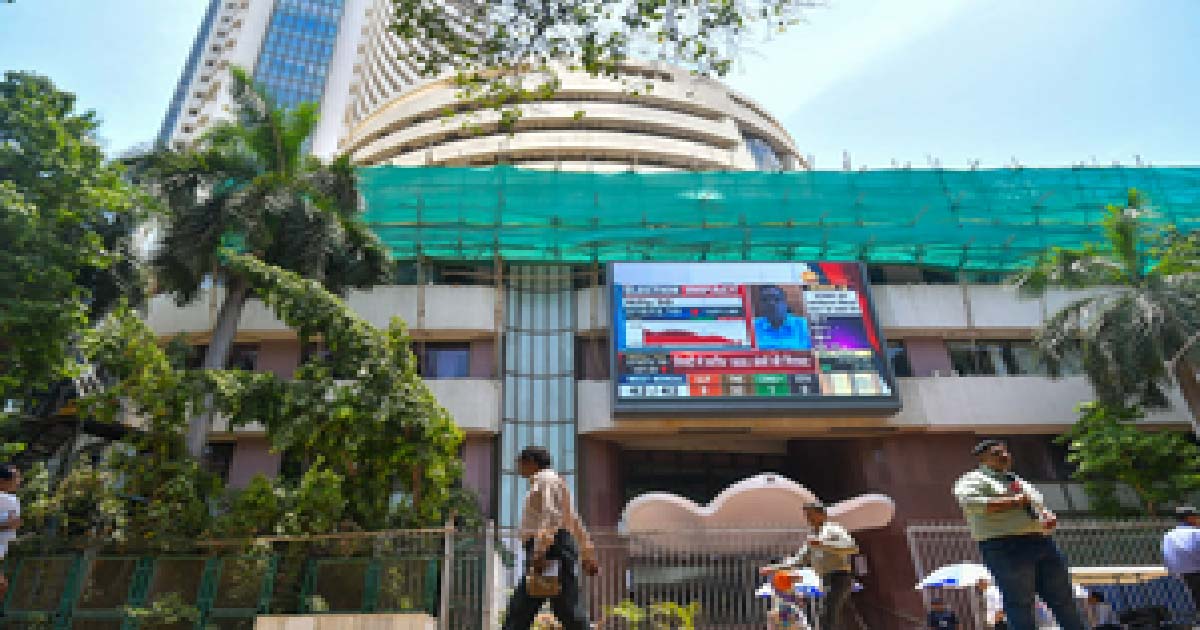
Mumbai, Dec 26: Indian benchmark indices opened flat with a mild negative bias on Friday, as markets are apparently in the consolidation phase amid lack of major cues.
As of 9.30 am, Sensex edged down 83 points, or 0.09 per cent to 85,325 and Nifty eased 17 points, or 0.06 per cent to 26,124.
Main broadcap indices outperformed benchmark indices in terms of gains, with the Nifty Midcap 100 advanced 0.35 per cent, while the Nifty Smallcap 100 added 0.27 per cent.
Cipla, Dr Reddys Labs and ONGC were among the major gainers in the Nifty Pack, while losers included Shriram Finance, Bajaj Finance, Tata Steel, Max Healthcare and TCS.
Among sectoral gainers, the Nifty Consumer Durables index was the top performer, rising 0.4 per cent, followed by Nifty Metal and Nifty Chemicals, which gained 0.3 per cent each.
The Nifty could extend its advance toward resistance levels at 26,202 and 26,330, while 26,000 is expected to provide near-term support.
With only four trading days left in 2025, what seemed to be a Santa rally appears to be fading as markets apparently consolidates without new triggers like a US-India trade deal, analysts said.
US GDP growth of 4.3 per cent in Q3 2025 is imparting resilience to the US market and the rising profitability of US companies, including AI ones, may prompt other FIIs, particularly fleet-footed hedge funds, to increase their investments there, they added.
Sustained buying by the cash rich DIIs will support the market and prevent a sharp pull back, market watchers said, adding that a market rally in early 2026 is likely, and valuation should be the top investment consideration.
Asia-Pacific markets traded higher in the morning session, with several indexes closed for the Boxing Day holiday
In Asian markets, China’s Shanghai index advanced 0.17 per cent, and Shenzhen edged up 0.31 per cent, Japan’s Nikkei added 0.99 per cent, while Hong Kong’s Hang Seng Index gained 0.17 per cent. South Korea’s Kospi added 0.7 per cent.
The US markets ended mostly in the green zone on the last trading day, as Nasdaq advanced 0.22 per cent, the S&P 500 edged up 0.32 per cent, and the Dow moved up 0.6 per cent.
On December 24, foreign institutional investors (FIIs) sold equities worth Rs 1,721 crore, while domestic institutional investors (DIIs) were net buyers of equities worth Rs 2,381 crore.
Business
HM Shah lays foundation stone for 1,655 industrial units ensuring Rs 2 lakh crore investment in MP
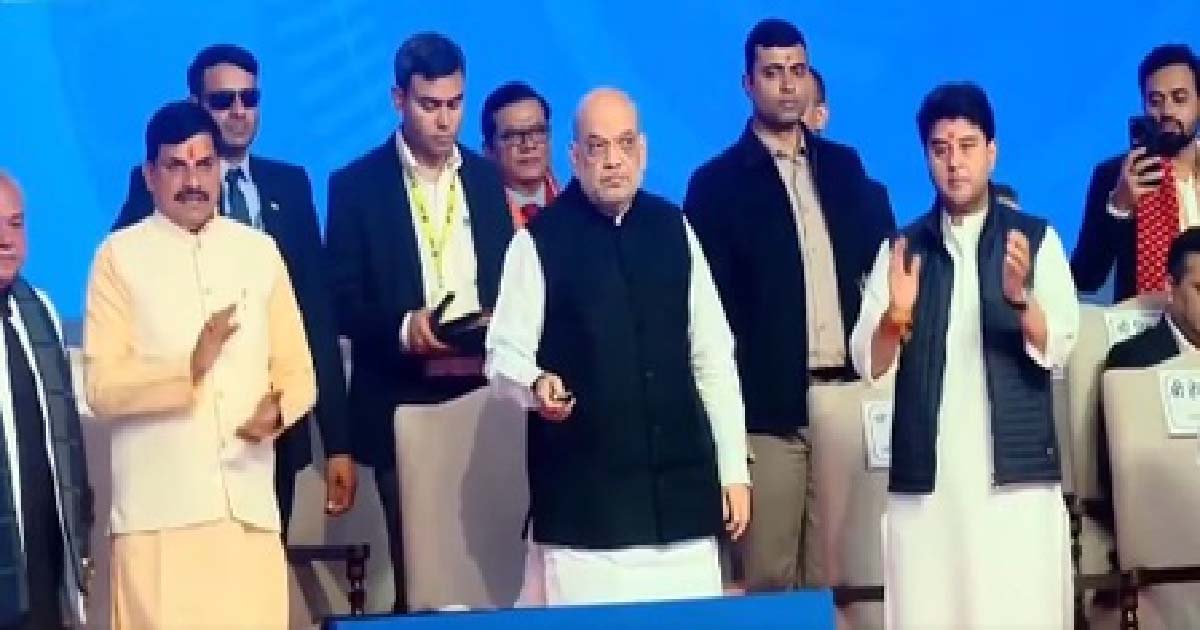
Gwalior, Dec 25: Union Home and Cooperation Minister Amit Shah delivered an inspiring address at the ‘Abhyudaya Madhya Pradesh Growth Summit’ here on Thursday, marking the 101st birth anniversary of former Prime Minister and Bharat Ratna recipient Atal Bihari Vajpayee.
Speaking on the theme ‘Investment to Employment – Atal’s Resolve, a Bright Madhya Pradesh’, HM Shah hailed the state’s rapid transformation under the double-engine government, declaring that Madhya Pradesh is emerging as the growth engine of ‘Viksit Bharat’.
HM Shah lavished praise on Chief Minister Mohan Yadav for pioneering initiatives aimed at balanced regional development across the state.
He highlighted CM Yadav’s innovative approach of organising regional investment promotion events and ground-breaking ceremonies in every division, ensuring equitable growth and unlocking the untapped potential of all areas.
“Chief Minister Mohan Yadav has taken thoughtful steps to establish a strong foundation for all-round development through his regional investment committees,” he said, adding that these efforts surpass even the energetic pace set by previous long-serving BJP Chief Minister Shivraj Singh Chouhan.
The Home Minister emphasised the critical importance of symmetrical industrial establishment to leverage Madhya Pradesh’s strategic geographical location.
He pointed to the traditional strength of cotton production in the Malwa and Gwalior-Chambal regions, noting that declining farmer incomes due to unfair prices could be reversed by setting up processing and allied industries locally. This would minimise transportation costs, make cotton farming profitable again, and connect seamlessly to markets in Delhi, western states, and nearby districts.
HM Shah described the day’s massive investment push – with foundation stones laid for 1,655 industrial units worth over Rs 2 lakh crore, expected to create 193,000 jobs – as a fitting tribute to former Prime Minister Vajpayee’s vision of good governance and national progress.
Held in Vajpayee’s birthplace, the summit, he said, embodied the late leader’s ideology of self-reliance, development, and inclusive growth, giving it a grand resonance on this auspicious occasion.
HM Shah expressed hope for continued central support, promising that true welfare stems from aligning with Prime Minister Narendra Modi’s vision for a prosperous India. The event, attended by prominent industrialists and cabinet ministers, reinforced Madhya Pradesh’s commitment to converting investments into widespread employment and regional prosperity.
Business
Gautam Adani hails war heroes, workers, farmers, and specially-abled as NMIA commences operations

Mumbai, Dec 25: Gautam Adani, Chairman of the Adani Group, hailed war heroes, farmers, and the specially abled as the Navi Mumbai International Airport (NMIA) — India’s newest Greenfield airport — welcomed its first passengers on Thursday.
The airport, inaugurated by Prime Minister Narendra Modi on October 8, began its operations on the day of Christmas.
Welcoming the first passengers, the Adani Group Chairman saluted the soldiers who protect the nation, workers who built the airport for their “unbreakable spirit”, farmers who feed the country, and the specially abled who inspire the nation.
“It was a deeply moving moment to stand beside Param Vir Chakra awardees Captain Bana Singh and Subedar Major Sanjay Kumar as the Navi Mumbai International Airport (NMIA) welcomed its very first passengers,” said Gautam Adani, in a post on social media platform X.
“In that moment, alongside the war heroes, stood the other quiet architects of the nation — the workers who built this airport with their bare hands and unbreakable spirit; the farmers and their families who feed India; the social workers who selflessly serve millions alongside the @AdaniFoundation; and our specially abled colleagues who inspire us every single day. For many of them, this was the first flight of their lives,” the Adani Group Chairman added.
“Soldiers who protect Bharat. Workers who build Bharat. Farmers who sustain Bharat. Social workers who serve Bharat. The specially abled who inspire Bharat,” the industrialist said.
Gautam Adani stated that NMIA showcases an opportunity for the country to move forward without leaving anyone behind.
“@AdaniPriti and I were deeply honoured to stand with them at NMIA – a moment that captured what this airport truly represents – opportunity with dignity, and a rising India that moves forward without leaving anyone behind,” the Adani Group Chairman said.
“Their blessings, their courage, and their resilience drive us every single day to build bigger, serve better, and work harder in service of the nation. Jai Hind,” the businessman added.
NMIA is a public-private partnership (PPP) between Mumbai International Airport Limited (MIAL), a subsidiary of Adani Airports Holdings Limited (AAHL), which holds the majority stake of 74 per cent, while the City and Industrial Development Corporation of Maharashtra Limited (CIDCO) hold the remaining 26 per cent.
In the first month, NMIA will operate for 12 hours — between 08:00 hours and 20:00 hours — handling 23 scheduled daily departures.
During the initial launch period, passengers will benefit from services operated by IndiGo, Air India Express, and Akasa Air, connecting Mumbai to 16 major domestic destinations.
Starting February 2026, the airport will transition to round-the-clock operations, expanding to 34 daily departures to meet the increasing needs of the MMR.
NMIA is also conducting comprehensive Operational Readiness and Airport Transfer (ORAT) trials in collaboration with all stakeholders, including security agencies and airline partners.
-

 Crime3 years ago
Crime3 years agoClass 10 student jumps to death in Jaipur
-

 Maharashtra1 year ago
Maharashtra1 year agoMumbai Local Train Update: Central Railway’s New Timetable Comes Into Effect; Check Full List Of Revised Timings & Stations
-

 Maharashtra1 year ago
Maharashtra1 year agoMumbai To Go Toll-Free Tonight! Maharashtra Govt Announces Complete Toll Waiver For Light Motor Vehicles At All 5 Entry Points Of City
-

 Maharashtra1 year ago
Maharashtra1 year agoFalse photo of Imtiaz Jaleel’s rally, exposing the fooling conspiracy
-

 National News1 year ago
National News1 year agoMinistry of Railways rolls out Special Drive 4.0 with focus on digitisation, cleanliness, inclusiveness and grievance redressal
-
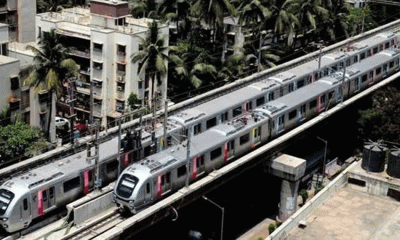
 Maharashtra1 year ago
Maharashtra1 year agoMaharashtra Elections 2024: Mumbai Metro & BEST Services Extended Till Midnight On Voting Day
-

 National News1 year ago
National News1 year agoJ&K: 4 Jawans Killed, 28 Injured After Bus Carrying BSF Personnel For Poll Duty Falls Into Gorge In Budgam; Terrifying Visuals Surface
-

 Crime1 year ago
Crime1 year agoBaba Siddique Murder: Mumbai Police Unable To Get Lawrence Bishnoi Custody Due To Home Ministry Order, Says Report



